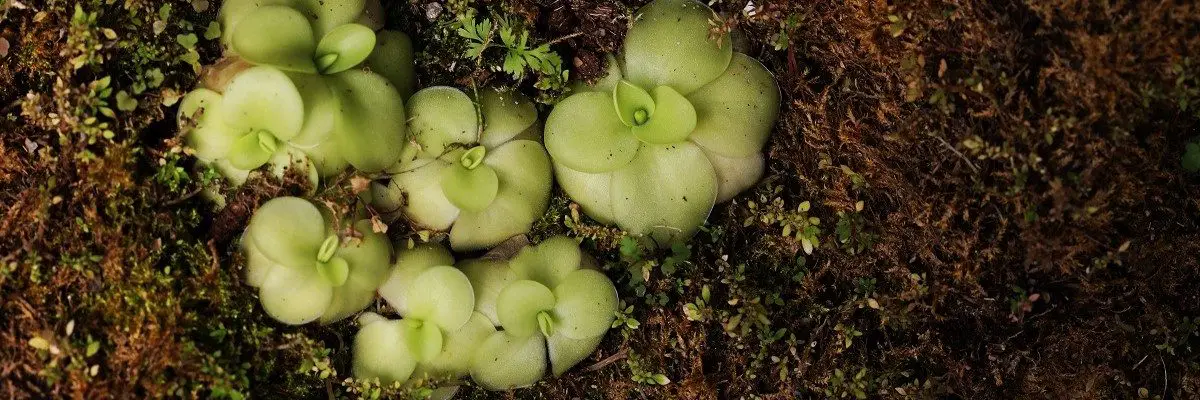Butterworts (Pinguicula) have been divided into cool temperate, warm temperate, and tropical environmental habitats. While the first type of plant requires dormancy, the other two do not. Below are the main elements needed to care for your Butterwort.
| 1. Watering Requirments | 2. Light Requirments |
| 3. Temperature | 4. Soil |
| 5. Food | 6. Fertilizing |
1. Watering Requirments For Butterwort
Butterwort is susceptible to rotting when the soil is too wet, unlike most other carnivorous plants. Ensure the soil is moist by top watering it whenever it feels dry. Don’t be afraid to pour water on your plants. Do not allow the soil to dry out completely. It will only take one day to replace the mucus washed off the leaves.
You may choose to keep your plant with a small amount of water in the pot, no more than 1/4 of the way up. The water should only be added to your tray when it has evaporated entirely.
Use rainwater whenever possible to water your plants. If this is not an option, let the water sit out for a few hours before using it to water your plants. You should also consider that the type of water you are using can affect your plants – too much salt or various minerals can kill them. As a result, certain chemicals and salts will evaporate. Another alternative is to use distilled water.
| Some tips are below, depending on where you live. |
|---|
| Cold climate: Plants that grow in cool climates require constant moisture during their growing season, which can be achieved by watering them with cool water. In the spring and fall, this occurs. When the weather gets colder, water them less. Just keep Butterworst moist but not soaking. |
| Warm climate: It will be necessary to provide a great deal of water to these plants. It will also be possible to use the tray method year-round. |
| Tropical climate: Keep wet from spring to summer, then reduce humidity and water in the fall and winter. |
2. Light Requirments For Butterwort
The amount of sunlight a plant need is one of the most important factors in its health. A light may be essential for those who live in cloudy climates to ensure that the pinguicula receives the light it needs to thrive. Butterwort can tolerate even the harshest weather conditions but prefers partial sunlight.
For example, they perform well under LED grow lights, in which light intensity is more consistent throughout the day. It would help if you used about 18-24w of LED lighting per square foot at a distance of about 12″. If the plants are close to the light, choose a lower wattage (12-18w) to avoid light dispersion. If the plants are further away, choose a higher wattage to prevent light dispersion.
All of the Butterworts benefit from partial shade. Observe if there is a transparent look to their leaves. If there is, the plant is getting too much sunlight.
| Quick Reference |
|---|
| Cool – cool shade conditions |
| Warm – partial shade – no direct light |
| Tropical – partial shade – no direct light |
3. Temperature For Butterwort
Butterworts generally can tolerate summer temperatures up to 95 degrees Fahrenheit in temperate regions (and winter temperatures up to 50 degrees Fahrenheit). Tropical butterworts prefer temperatures that are a bit warmer. Humidity and plenty of moisture are essential to both kinds.
Various types of butterworts can be grown at different temperatures worldwide due to their widespread distribution. Mexican butterworts do best in warm environments, such as greenhouses or terrariums. When dormant, Pinguicula species in the temperate zone can withstand cold winters. In contrast, those in the warm temperate zone can tolerate light frosts.
Tropical butterworts are warm-loving plants. The foliage becomes less carnivorous in butterworts and grows closer together as they enter their dormant season. You can stop watering the butterworts when they go dormant. The best approach is to mist them every now and then instead of fully watering them.

4. Soil For Butterwort
To maintain temperate conditions, you can use a mix of two parts peat to, one part sand to one part perlite. Generally, warm-climate varieties do best in soils containing one part peat and one part sand. Plants from Mexico and the tropics benefit from a more open mix of sand, perlite, vermiculite, and peat. It is sometimes added to this with dolomite or gypsum, though we have not found it necessary. It is also a good idea to add a little pumice or lava rock to the mix when you can. It is also possible to grow them in a Nepenthes mix.
5. Food For Butterwort
Butterworts capture food pretty well on their own. Sprinkle some fish food or bloodworms every 2-3 weeks if they seem to be having trouble. You may want to keep food away from the sensitive crown to prevent bacterial and mold growth. During certain times of the year, Butterworts go into dormancy. The leaves become less sticky, and the plants usually become smaller. Butterworts do not need to be fed during this time.
6. Fertilizing For Butterwort
Pinguiculas will not respond well to regular houseplant food because they evolved to catch their own ‘fertilizer.’ You can use most fertilizers on your Pinguicula esseriana, but they will quickly kill it. You should only use any if you are an expert in growing carnivorous plants.
Plant growers tend to underestimate how many bugs have to be caught by carnivorous plants. Pinguicula esseriana typically thrives in an environment where other plants are present, usually in the home or outside.


